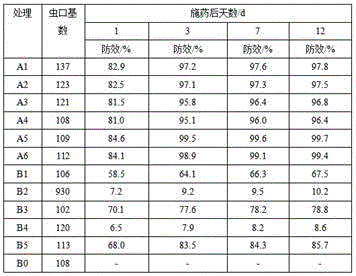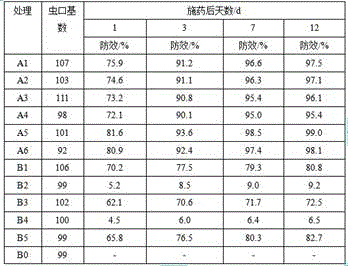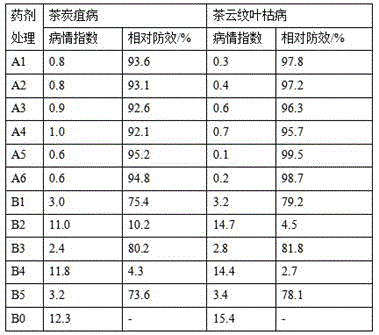Botanical pesticide for preventing and treating diseases and insect pests of tea trees
A plant-derived pesticide, pest and disease technology, applied in the field of pesticides, can solve the problems of slow drug effect, increased pest resistance, unfavorable pest control and other problems, achieve significant control effect, broad antibacterial and insecticidal spectrum, and less resistant to pesticides
- Summary
- Abstract
- Description
- Claims
- Application Information
AI Technical Summary
Problems solved by technology
Method used
Image
Examples
Embodiment 1
[0025] Embodiment 1: A plant-derived pesticide for preventing and controlling tea plant diseases and insect pests, prepared from the following raw materials in parts by weight: 15 parts of saponins, 15 parts of Araceae, 15 parts of fleas, 15 parts of lilacs, 10 parts of cinnamon, and 10 parts of carnations , 10 parts of Magnolia officinalis, 10 parts of Lingxiang, 7 parts of arborvitae leaves, 7 parts of pinellia, 7 parts of banana root, and 5 parts of licorice.
[0026] The preparation method of the botanical pesticide of present embodiment prevention and treatment tea plant disease and insect pest, comprises the following steps:
[0027] 1) Weigh the saponins and Aracea in the above parts by weight, mix and crush them to obtain the pulverized material I; weigh the above parts by weight of flea, lilac, carnation, magnolia officinalis, Pinellia pinellia, banana root and licorice, Mixing and pulverizing to obtain pulverized material II; respectively weighing parts by weight of ...
Embodiment 2
[0039] Embodiment 2: A plant-derived pesticide for preventing and controlling tea plant diseases and insect pests, prepared from the following raw materials in parts by weight: 22 parts of saponins, 25 parts of Araceae, 25 parts of fleas, 22 parts of lilacs, 12 parts of cinnamon, and 12 parts of carnations , 12 parts of Magnolia officinalis, 10 parts of Lingxiang, 7 parts of arborvitae leaves, 8 parts of pinellia, 9 parts of banana root, and 8 parts of licorice.
[0040] The preparation method of the botanical pesticide of present embodiment prevention and treatment tea plant disease and insect pest, comprises the following steps:
[0041] 1) Weigh the saponins and Aracea in the above parts by weight, mix and crush them to obtain the pulverized material I; weigh the above parts by weight of flea, lilac, carnation, magnolia officinalis, Pinellia pinellia, banana root and licorice, Mixing and pulverizing to obtain pulverized material II; respectively weighing parts by weight of ...
Embodiment 3
[0050] Embodiment 3: A kind of botanical pesticide for the prevention and treatment of tea tree diseases and insect pests, prepared from the following raw materials in parts by weight: 13 parts of saponins, 13 parts of Araceae, 13 parts of fleas, 13 parts of lilacs, 8 parts of cinnamon, and 8 parts of carnations , 8 parts of Magnolia officinalis, 8 parts of Lingxiang, 6 parts of arborvitae leaves, 6 parts of pinellia, 6 parts of banana root, and 4 parts of licorice.
[0051] The preparation method of the botanical pesticide of present embodiment prevention and treatment tea plant disease and insect pest, comprises the following steps:
[0052] 1) Weigh the saponins and Aracea in the above parts by weight, mix and crush them to obtain the pulverized material I; weigh the above parts by weight of flea, lilac, carnation, magnolia officinalis, Pinellia pinellia, banana root and licorice, Mixing and pulverizing to obtain pulverized material II; respectively weighing parts by weight...
PUM
 Login to View More
Login to View More Abstract
Description
Claims
Application Information
 Login to View More
Login to View More - R&D
- Intellectual Property
- Life Sciences
- Materials
- Tech Scout
- Unparalleled Data Quality
- Higher Quality Content
- 60% Fewer Hallucinations
Browse by: Latest US Patents, China's latest patents, Technical Efficacy Thesaurus, Application Domain, Technology Topic, Popular Technical Reports.
© 2025 PatSnap. All rights reserved.Legal|Privacy policy|Modern Slavery Act Transparency Statement|Sitemap|About US| Contact US: help@patsnap.com



